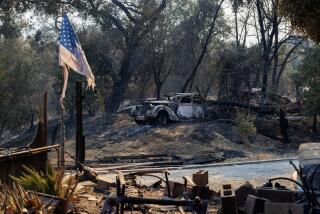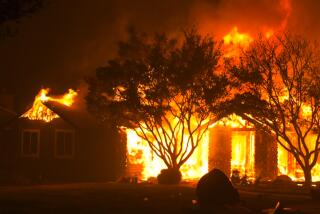Storm Warning : Banks Flood Homeowners With Insurance Demands
Homeowner Robert Dallek was feeling low when his banker told him that his West Los Angeles neighborhood had been declared a depressed area.
The bank sent an urgent letter demanding that Dallek immediately take steps to protect his house. Not from shrinking property values, but from rising floodwaters.
Hydrologists had determined that Dallek’s expensive Rancho Park neighborhood was sitting in a low-lying flood hazard zone. Bankers worried that a “100-year flood” could cause water to surge over Prosser Avenue and damage his 58-year-old Spanish-style house.
Never mind that Los Angeles is entering its fifth year of drought or that rainwater has never lapped at Dallek’s doorstep even though four 100-year deluges have apparently occurred since he moved into his house 20 years ago.
The bank demanded that he immediately purchase flood insurance.
“I’ve never seen anything like even a hint of an inundation here,” said the UCLA history professor, author of books on Presidents Ronald Reagan and Franklin D. Roosevelt. “My reaction was that it was inconceivable there could be a flood.
“But the bank said, ‘Pay up . . . you’ve got 18 days.’ My suspicions were aroused. Maybe this was some sort of scam.”
It was not.
Notices such as the one Dallek got are being mailed by the thousands to Los Angeles-area homeowners from banks and savings and loans that are suddenly eager to protect themselves in the wake of the ongoing S&L; crisis.
Flood insurance for low-lying homes in the Los Angeles Basin has been required by federal officials for 10 years. The coverage is available through a national program that was set up in 1973 to make affordable insurance available and decrease government relief costs after major rainstorms and hurricanes.
In Los Angeles, county flood control hydrologists were hired by the federal government to map flood hazard areas. Between 1978 and 1980, they studied topography and geology surveys, read up on previous storm damage in back issues of The Times and examined neighborhood storm drain systems as a way of calculating what areas might be flooded in future storms.
About 1% of the Los Angeles Basin ended up shaded as gray danger zones on the 1,000 street-by-street “flood insurance rate map” panels produced for the Federal Emergency Management Agency, said Frank Williams, flood insurance engineer for the county’s Department of Public Works.
Although insurance has routinely been required of those buying homes in flood hazard zones since the maps were finished, banks have been lax about requiring coverage from homeowners who bought before 1980.
As a result, federal officials estimate that less than 15% of homes in flood zones have the coverage. In Los Angeles County, 7,161 homes are protected, but an unknown number are not, according to the Federal Insurance Administration.
“Most people believe regular homeowners insurance covers flooding, but it does not,” said Jack Heldridge, flood insurance chief for FEMA in San Francisco.
“The standard single-family house in the U.S. has about a 1% chance of having a damaging fire over a 30-year period and everyone has fire insurance. But a house in a special flood area has a 26% chance of being damaged in a 30-year mortgage period,” Heldridge said.
The current flood of insurance notices being sent to homeowners has apparently been prompted by the savings and loan crisis. Also, some lending institutions are looking to raise cash quickly by selling parts of their mortgage portfolios, banking experts say. Loan refinancing or an application for a home equity loan can also trigger a flood insurance notice, they said.
“If the FDIC (Federal Deposit Insurance Corp.) moves in to bolster a bank, it looks at mortgages to see if they are readily marketable,” said James Rose, an administrative assistant for the Federal Insurance Administration in Washington.
“If they’re in a flood hazard area but not protected by flood insurance, the Federal National Mortgage Assn. and the Federal Home Loan Mortgage Corp. won’t purchase that mortgage. Banks that would like to unload some of their mortgages to get liquidity all of a sudden find this to be of critical importance.”
Banks are also being pressured by federal regulators to tighten up on the insurance, Rose said. That pressure has indirectly come from a congressional committee, which learned two years ago that insurance coverage was lagging.
Some banks have hired “search firms” to study their mortgages to determine whether properties are located in designated flood hazard zones, he said. Rather than compare each address with local flood maps, some searchers have taken the easy way out and sent notices to all mortgage holders in an area--even those outside the flood zone.
“We get complaints,” Rose said. “People say it puts the burden on them to tell the banks they’re not in a special flood hazard area.”
Bank officials acknowledge that there has been a stepped-up government interest in flood insurance.
“We can confirm that regulators have been taking a much closer look,” said Rick Beebe, a spokesman for Bank of America, which sent Dallek his notice.
“It is possible a borrower may not have been required to have this insurance when the loan originated, but as a result of the change in requirements, they may now have to get it,” he said.
Los Angeles-area officials say that they get more than 100 telephone inquiries a day about flood zones. City and county engineers search out each address on their flood hazard maps to verify whether the home sits in a flood zone.
Homeowners who are lucky enough to discover that they live outside the flood boundaries are required to provide written proof to their banks in order to avoid having to buy insurance. Some government offices charge up to $50 for such certification.
“The banks are hard-nosed. They want a letter,” said the county’s Williams, whose office charges a $30 processing fee. It recently assigned a full-time technician to handle the growing number of homeowner inquiries.
In the San Fernando Valley, lending institutions are sending out mass mailings that instruct homeowners to pay up or provide proof that they are not in flood zones, said George Groves III, a civil engineer for Los Angeles. “Ninety percent of them don’t need the insurance,” he added.
Mico Rousso, a city engineer who has plugged an answering machine into his City Hall phone to handle calls and complaints about flood notices, said many homeowners ask how they can sidestep the insurance requirement.
“I tell them not to jeopardize their mortgage, to pay it now and then try to fight it later,” Rousso said.
The flood maps are confusing to many people, he said. “It doesn’t make sense why there would be a clean zone here and a danger zone here,” he said, tracing his finger along a map of the Hollywood area that showed one side of Normandie Avenue as a flood zone--but the other side as safe.
Future storm drain projects, such as a $15-million system to be installed near Farmers Market, will result in thousands of Los Angeles homes being removed from designated flood zones, officials said.
Meanwhile, homeowners continue to be alternately puzzled and infuriated by the insurance notices. They are also confused about the 100-year flood designation because several purported 100-year storms have occurred in recent years without causing flooding.
Officials define a 100-year flood as an inundation that has a 1% chance of occurring in any given year. A 100-year storm is one that has the same likelihood of occurring.
Experts point out that such a downpour does not automatically cause a 100-year flood. A deluge that dumps about 1 1/2 inches of rain per hour can be designated a 100-year storm, although variables such as how long the rain falls, how saturated the ground is, steepness of terrain and whether street drains are clogged also determine whether flooding occurs.
Stephanie Palmer, co-manager of Jon Douglas Co. Realtors in West Los Angeles, said she has instructed real estate agents to closely study a hand-drawn flood map that is posted in her office. “We’ve never seen a sale canceled because of it, but the flood zone could cause problems if it’s not disclosed,” she said.
Palmer’s office lies within the same Westside flood zone as Dallek’s. Officials say that the area has the potential of being inundated from runoff from the Beverly Glen section of the Santa Monica Mountains a few miles to the north.
The office of insurance agent Ellis Winzler also sits inside the same flood zone. He scoffs at the flood insurance requirement.
“Why, after 70 years have gone by without a problem in this area, are they asking people to go through this nonsense?” asked Winzler, who has worked for 41 years in West Los Angeles.
“If I write one of the policies, I make a buck. But it’s baloney. I hate to see people all of a sudden get hit with $200 or $500 worth of insurance they don’t need.”
A few blocks away, Dallek laughed when told that flood maps indicate that his house is 14 feet lower than houses that are a block or so away. His neighborhood has always looked pretty flat to him, he said.
“I bought the flood insurance against my better judgment. It cost me $265,” he said, gazing up the street.
“Let it rain.”
More to Read
Sign up for Essential California
The most important California stories and recommendations in your inbox every morning.
You may occasionally receive promotional content from the Los Angeles Times.











